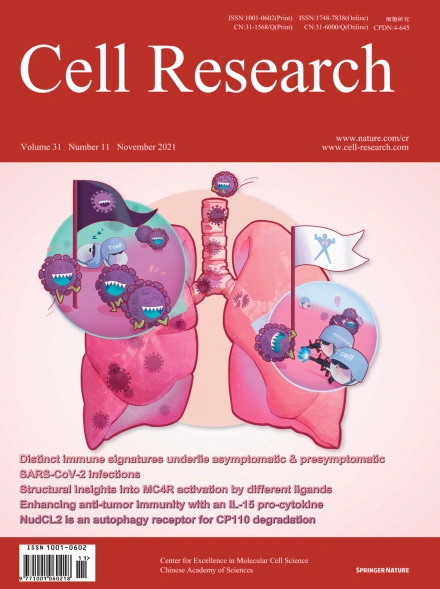
Advanced Search
Submit Manuscript
Advanced Search
Submit Manuscript
Volume 31, No 11, Nov 2021
ISSN: 1001-0602
EISSN: 1748-7838 2018
impact factor 17.848*
(Clarivate Analytics, 2019)
Volume 31 Issue 11, November 2021: 1176-1189 |
Structures of active melanocortin-4 receptor–Gs-protein complexes with NDP-α-MSH and setmelanotide
Nicolas A. Heyder1 , Gunnar Kleinau1,† , David Speck1,† , Andrea Schmidt1,† , Sarah Paisdzior2,† , Michal Szczepek1 , Brian Bauer1 , Anja Koch11 , Monique Gallandi1 , Dennis Kwiatkowski1 , Jörg Bürger3,4 , Thorsten Mielke4 , Annette G. Beck-Sickinger5 , Peter W. Hildebrand3,6,7 , Christian M. T. Spahn3 , Daniel Hilger8 , Magdalena Schacherl3 , Heike Biebermann2 , Tarek Hilal9 , Peter Kühnen2 , Brian K. Kobilka7,10 , Patrick Scheerer1,11,*
1Charité – Universitätsmedizin Berlin, corporate member of Freie Universität Berlin and Humboldt-Universität zu Berlin, Institute of Medical Physics and Biophysics, Group Protein X-ray Crystallography and Signal Transduction, Charitéplatz 1, Berlin, GermanyThe melanocortin-4 receptor (MC4R), a hypothalamic master regulator of energy homeostasis and appetite, is a class A G-protein-coupled receptor and a prime target for the pharmacological treatment of obesity. Here, we present cryo-electron microscopy structures of MC4R–Gs-protein complexes with two drugs recently approved by the FDA, the peptide agonists NDP-α-MSH and setmelanotide, with 2.9 Å and 2.6 Å resolution. Together with signaling data from structure-derived MC4R mutants, the complex structures reveal the agonist-induced origin of transmembrane helix (TM) 6-regulated receptor activation. The ligand-binding modes of NDP-α-MSH, a high-affinity linear variant of the endogenous agonist α-MSH, and setmelanotide, a cyclic anti-obesity drug with biased signaling toward Gq/11, underline the key role of TM3 in ligand-specific interactions and of calcium ion as a ligand-adaptable cofactor. The agonist-specific TM3 interplay subsequently impacts receptor–Gs-protein interfaces at intracellular loop 2, which also regulates the G-protein coupling profile of this promiscuous receptor. Finally, our structures reveal mechanistic details of MC4R activation/inhibition, and provide important insights into the regulation of the receptor signaling profile which will facilitate the development of tailored anti-obesity drugs.
https://doi.org/10.1038/s41422-021-00569-8